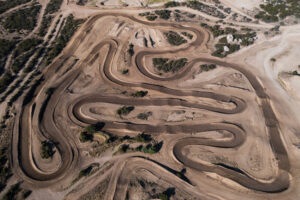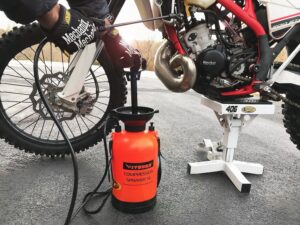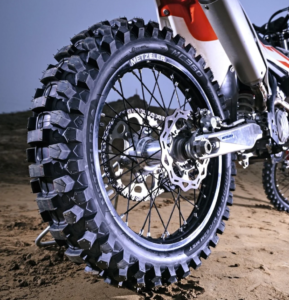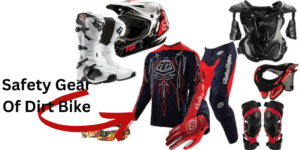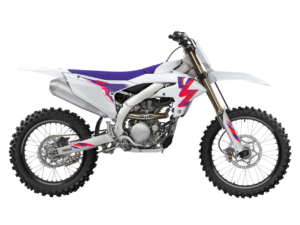Useful Information about Dirt Bike Tires
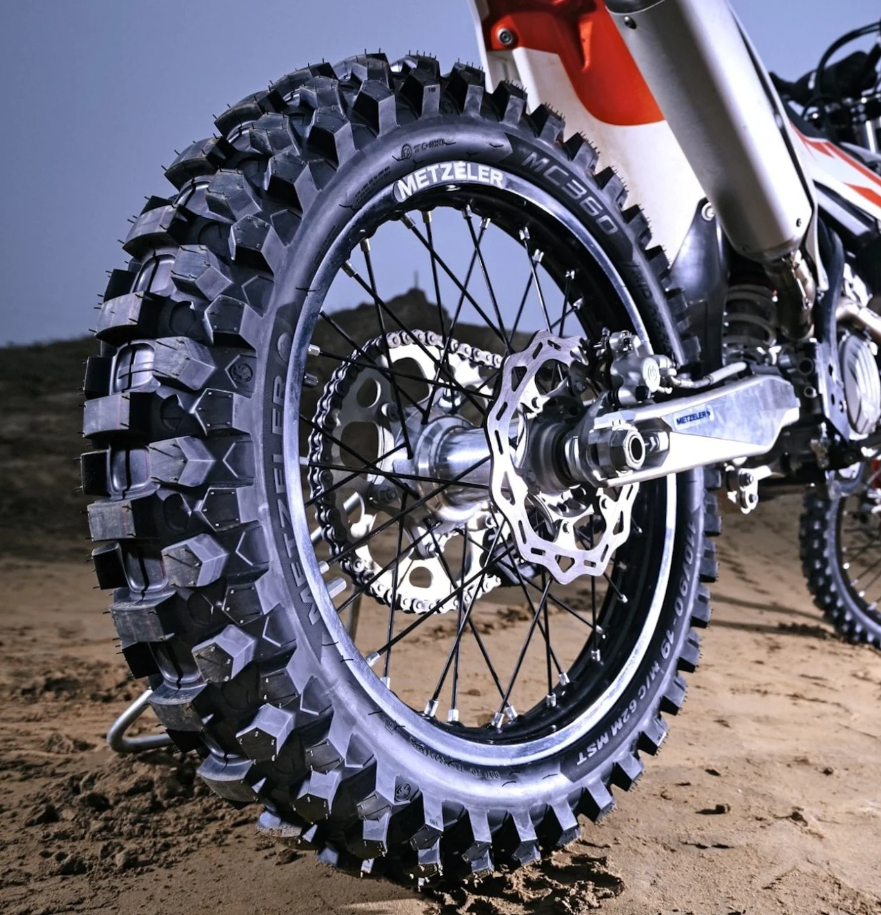
An essential part of off-road motorcycles meant for travel on rough, uneven terrain are dirt bike tires. For grip, control, and stability on a variety of conditions, such as dirt trails, mud, rocks, sand, and gravel, these specialty tires are important. The following details pertain to tires for dirt bikes:
The most popular kind of tires for dirt motorcycles are known as knobby tires. Their tread is made up of big, aggressive, widely spaced knobs that provide improved grip on loose or uneven surfaces.
Trials Tires: Trials tires feature a distinct tread pattern with knobs that are narrower and closer together. When it comes to rocks and other rough terrain, they offer outstanding grip.
Sand tires: Designed specifically for improved flotation and traction in sandy environments, these tires have paddles or big, widely spaced knobs.
Tire Size: Front and rear dirt bike tires are available in a range of sizes. Usually, the tire’s sidewall will have the size listed. Common sizes are given in inches, for example, front sizes are 80/100-21 and back sizes are 110/100-18. The width is indicated by the first number, while the rim diameter is shown by the second.
Tread Patterns: Tread patterns are designed for specific types of terrain. The depth, size, and spacing of the knobs determine a tire’s suitability for different conditions. Knobby tires are versatile and perform well in a range of off-road environments.Tread Patterns: Different types of terrain call for different tread patterns. The knobs’ size, depth, and spacing dictate which circumstances a tire is appropriate for. Because of their adaptability, knobby tires work well in a variety of off-road conditions.
Tire Construction: To resist the hardships of off-road riding, dirt bike tires are made of sturdy rubber compositions. In order to withstand punctures and pinch flats, their sidewalls are frequently strengthened.
Certain dirt bike tires don’t need inner tubes, whereas others do. Because they can save weight and the possibility of pinch flats, tubeless tires are growing in popularity.
Tire Pressure: For the best possible handling and performance, the tire pressure is vital. It varies according to rider choice and the terrain. In soft terrain, such as sand or mud, lower tire pressure offers better grip; on hard-packed surfaces, higher tire pressure is preferable.
Tire Care: To ensure that dirt bike tires last a long time and operate well, regular care is essential. Prior to each ride, check the tire pressure, look for wear or damage, and replace the tires as the tread wears out.
Riding Style: The dirt bike tires you choose should complement both your riding style and the types of terrain you usually ride on. on optimal grip, aggressive riders could pick knobby tires; on tricky and rocky routes, trials or hybrid tires are appropriate.
Brand and Model: Dunlop, Michelin, Pirelli, Bridgestone, and other respectable tire producers are among those that sell dirt bike tires. Tire lifetime and performance can be affected by the brand and model selection.
Directional Tires: For optimum performance, certain dirt bike tires are made to rotate in a certain direction. For optimal traction, always be sure you mount them appropriately.
How Dirt Bike Tires work ?
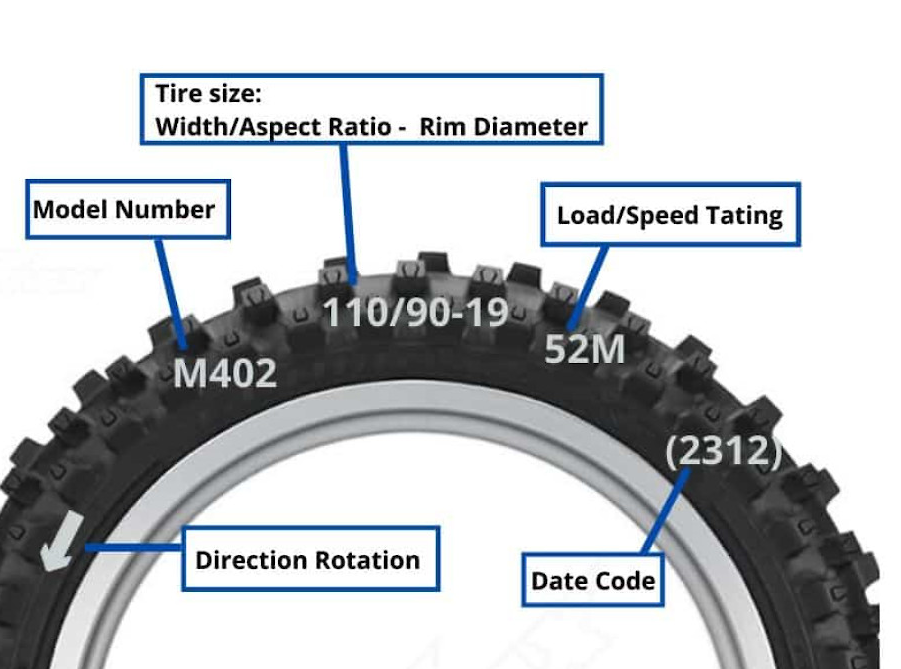
Designed to offer grip and control on a variety of terrains, dirt bike tires are an essential part of off-road motorcycles. With their deep, aggressive knobs or lugs, these tires offer a unique tread pattern that helps the bike stay stable even in difficult situations like mud, sand, pebbles, or dirt. Riding across rough terrain is made easier for the rider by the tires’ ability to adapt to irregular surfaces thanks to their composition and flexibility of rubber compound. Furthermore, the sidewalls of the tire are constructed to resist the demands of off-road riding, cushioning impacts and avoiding punctures. All things considered, the traction, toughness, and control that are required for a fun and secure off-road riding experience are meticulously developed into dirt bike tires.
Specialized dirt bike tires are essential to maintaining the bike’s functionality. Riders may fine-tune their bike’s handling qualities by adjusting the tire pressure to suit different terrains. Higher tire pressure offers better stability and control on hard-packed trails, while lower tire pressure gives more traction and a smoother ride on softer conditions like mud or sand. Dirt bike tires may be used in a variety of off-road situations thanks to its tread pattern, design, and tire pressure optimization. Because the correct tires may greatly affect a rider’s overall riding experience, safety, and ability to successfully navigate a variety of off-road problems, riders frequently pay special attention to the selection and upkeep of their tires.
On Road Vs Off-road Tires for Dirt Bike
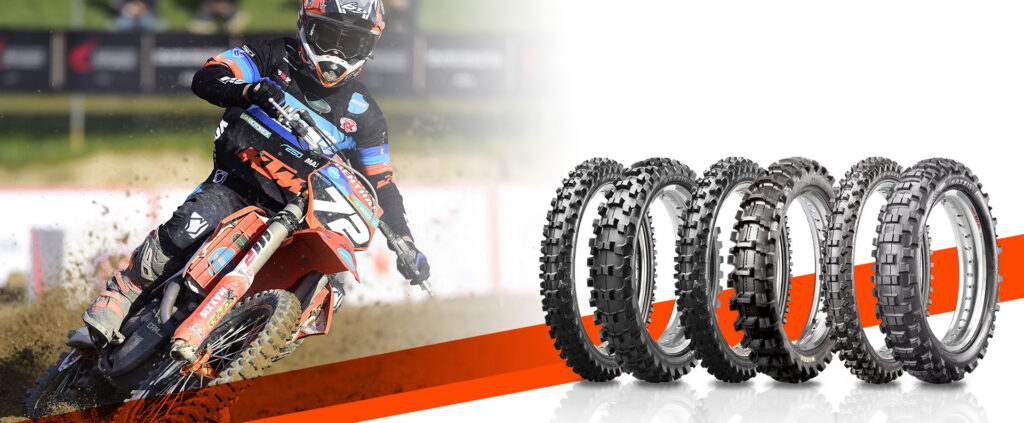
For dirt motorcycles, there are two types of tires: on-road and off-road. They are made for diverse uses and have unique characteristics to fit the particular terrain and riding circumstances. For dirt motorcycles, the following are some of the main variations between the characteristics and capabilities of on-road (street) and off-road (knobby) tires:
On-Road (Street) Tires for Dirt Bikes
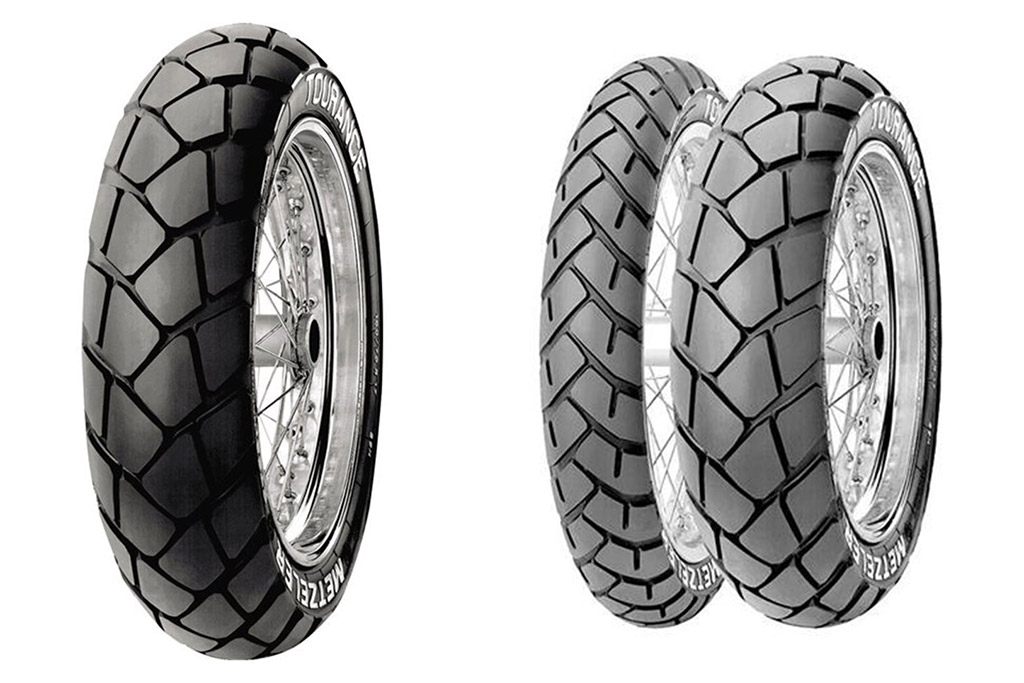
Smooth Tread Pattern: The tread pattern of on-road tires is continuous, smooth, and has either few or no knobs. On smooth, paved areas, this shape maximizes contact with the road surface and delivers good grip.
High-Speed Stability: On concrete or asphalt roads, street tires are designed to function best when cornering and at high speeds. They are made to hold firmly in these circumstances.
Durability: These tires are made to resist the abrasions that come with long rides on paved roads. For durability, they frequently have a tougher rubber composition.
Decreased Rolling Resistance: When riding on smooth surfaces, the lower rolling resistance of on-road tires enhances fuel efficiency and overall ride comfort.
Unsuitable for Off-Road Use: Street tires are not made for off-road driving and may not offer enough grip on loose or uneven surfaces like sand, mud, rocks, and dirt tracks.
Off-Road (Knobby) Tires for Dirt Bikes
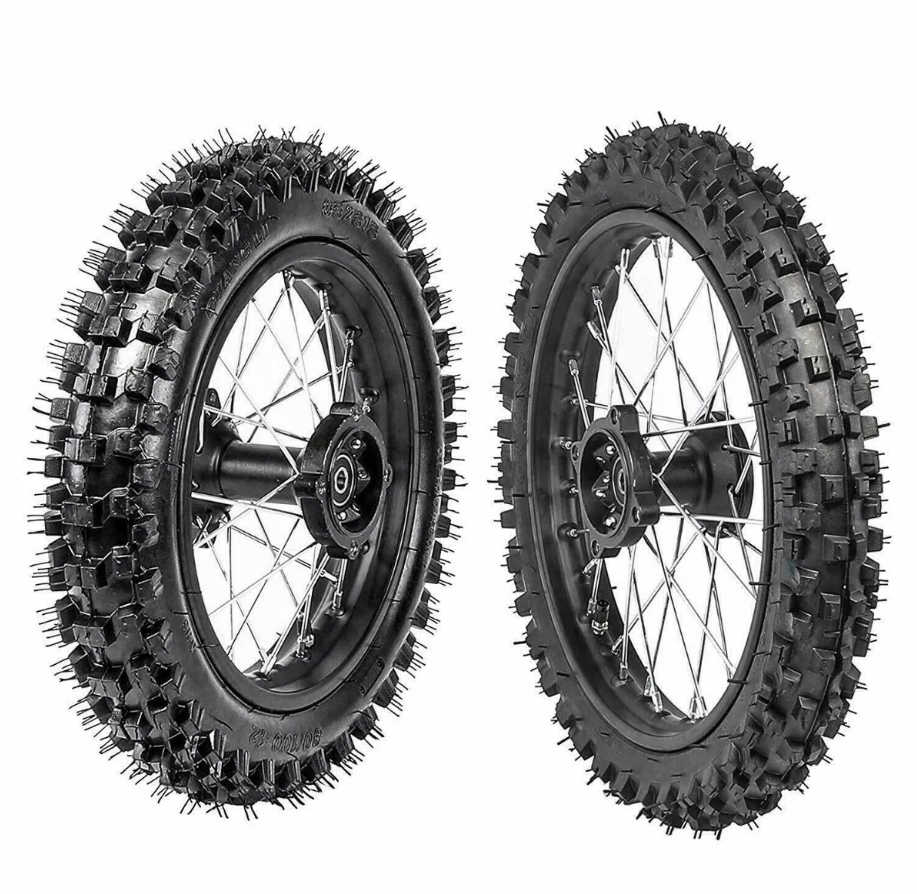
Aggressive Tread Pattern: Deep lugs or knobs characterize the aggressive, knobby tread pattern of off-road tires. The goal of this design is to maximize traction in difficult off-road circumstances.
Versatility: Off-road tires are designed to handle a variety of surfaces, such as mud, gravel, pebbles, sand, and dirt trails. Deep treads provide stability and traction on uneven and rough terrain.
Shock Absorption: By absorbing shocks and vibrations from tough terrain, these tires improve off-road rider comfort.
Soft Rubber Compounds: Because they grip effectively on a variety of terrain, off-road tires frequently employ softer rubber compounds. On hard, abrasive surfaces, however, this softness may cause wear to occur more quickly.
Not Suitable for On-Road Use: Riding a dirt bike on the street for lengthy periods of time is not advised, even though they can be done with off-road tires. On smooth surfaces, the aggressive knobs result in decreased stability and increased rolling resistance.
To sum up, the main purpose of on-road tires for dirt motorcycles is to offer durability, stability, and grip on paved roads, whilst off-road tires are made to give the most traction and control possible on a variety of off-road surfaces. The kind of terrain you’ll be riding on and your riding tastes will determine which of these two tire types you should choose. Some riders could even choose a hybrid tire, which offers a halfway ground between off-road and on-road performance.
5 Best Dirt Bike Tires Brands
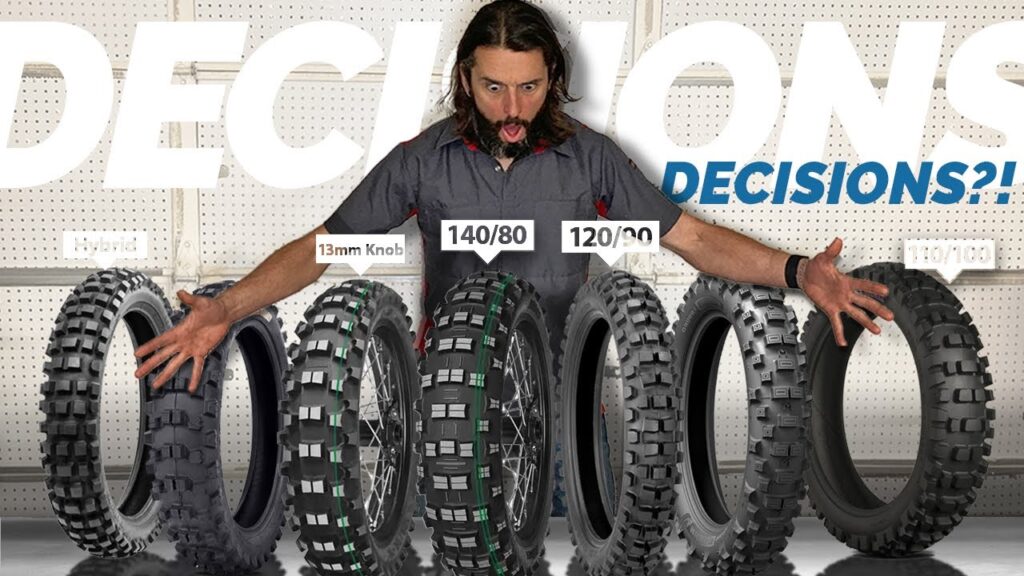
Selecting the best dirt bike tires and manufacturers may be arbitrary because it frequently relies on your riding style and tastes. I can, however, provide you a list of reputable and well-known dirt bike tire manufacturers, along with a few well-liked models that are well rated by riders. These manufacturers and models are renowned for their dependability and performance in a range of off-road scenarios:
Michelin: Michelin provides a selection of dirt bike tires, such as the Michelin Enduro Medium and StarCross 5. The traction and longevity of these tires are well-known.
Dunlop: Dunlop tires are a reliable brand that include the Dunlop D606 and the Dunlop Geomax MX33. They have a reputation for having outstanding traction and performance in off-road and motocross riding.
Pirelli: Dirt bike racers frequently choose between the Pirelli MT16 and the Pirelli Scorpion MX32. Because of its superior grip and versatility in a range of conditions, Pirelli is highly acclaimed.
Bridgestone: Riders looking for a tire that strikes a mix of lifespan and grip choose the Bridgestone M203 and Battlecross X30.
Kenda: Models such as the Kenda Ibex and K760 Trakmaster II are affordable solutions from Kenda. These tires are renowned for being affordable and versatile.
Remember that your riding style, the type of terrain you ride on a regular basis, and your skill level will all determine which dirt bike tire is ideal for you. To choose the tire that best meets your demands, it’s a good idea to speak with other riders and get professional guidance at a nearby motorcycle store. When choosing your choice, keep in mind that several aspects such as tire size, compound, and tread pattern can affect how well your bike performs.
How to Pick a Gummy Tire for your ATV or Motorcycle
For the best off-road performance on your dirt bike, select the appropriate gummy tire. The first thing to think about is the kind of terrain you’ll be riding on; aggressive tread patterns and softer compounds perform best on rocky or difficult trails, while tougher compounds perform better on firmer terrain. Next, consider the tire’s dimensions and profile to make sure it meets the requirements of your bike and has the appropriate handling qualities. Evaluating the tire’s durability is also essential because sticky tires often wear out more quickly. Look for a brand and model that is renowned for its durability and grip by reading reviews and asking other riders for advice. Your decision should ultimately take into account both your riding style and the unique difficulties of the off-road terrain you have selected.
HOW TO MAKE QUALITY SPIKED WINTER TIRES FOR A DIRT BIKE
A dirt bike’s spiked winter tires need to be made with some simple supplies and skill. To begin, get a set of knobby off-road tires that fit the size of your bike. Next, select suitable studs or spikes made for ice conditions. In order to achieve balanced traction, carefully drill holes into the tire knobs and insert the spikes, making sure they are fairly placed. To stop them from slipping away while riding, firmly attach them using glue. Give the glue time to completely cure. Lastly, make sure the spikes offer superior grip for winter off-road riding by double-checking the balance of your tire and making any required modifications before putting them on your dirt bike. Always put safety first and pay attention to local laws while utilizing tires with spikes.
Tips on How to Change a Dirt Bike Tire
Although changing a dirt bike tire might be difficult, you can do it yourself if you have the necessary equipment and follow a logical procedure. The following advice will assist you in changing a dirt bike tire.
Instruments & Devices:

Tire irons: To remove the old tire and install the new one, you’ll need a set of tire irons, also known as levers.
Spoons made of tires: These are useful for forcing the tire past the rim.
Tire stand: To make the task easier, use a stand or a means to raise the bike.
A bead breaker is a tool used to help separate the old tire’s bead from the rim.
Remove the valve core to let the tire’s air out.
Tire lubricant: A solution of soapy water might facilitate the tire’s easier rim-to-tire sliding.
Air compressor: To put air in the new tire once it is mounted on the wheel.
Wear gloves and safety eyewear to shield your hands and eyes while working.
Step-by-Step Process on how to Change a Dirt Bike Tire
Organize the Workspace: Seek out a level, well-lit space to work on your bicycle. Securely raise the bike using a stand or other support.
Let the Air Pressure Drop: Take off the valve cover. To completely deflate the tire, use the valve core extractor.
Shatter the Bead: To break the bead on both sides of the tire, place the tire bead breaker on the sidewall and apply pressure. Continue doing this while rotating the tire until the bead is completely shattered.
Take the Tire Off: Working your way around the tire, carefully peel it away from the rim with the tire irons. When doing this, take care not to harm the rim or inner tube.
Put the New Tire in Place: Apply a soapy water solution to the tire beads and rim to lubricate them. Slide the tire onto the rim with caution, starting at the valve stem. Work your way around the tire and use tire irons or spoons to help lift it over the rim. Make sure the tire is positioned equally on the rim on both sides.
Pump up the tire: Place the valve core back in. To have the tire inflated to the necessary pressure, use an air compressor. Look for any obvious indications of tire bulging, since this may be a symptom of incorrect seating. Deflate the tire and replace it if you see this.
Check Tire Balance: Make sure the tire is well balanced by using a tire balancer, if you have one.
You can roughly balance the tire even without a balancer by placing little weights on the rim.
Look for any leaks: To check for leaks, spray the tire with a solution of soapy water. Leaks will cause bubbles to appear.
Put the bike’s tire back on: Reinstall the tire on the bike with caution, being sure the sprockets and chain are in the right positions. Adjust the axle and measure the tension in the chain.
Trial Ride: Do a quick test ride on your dirt bike to make sure the tire is balanced and mounted correctly.
For detailed directions and torque settings, don’t forget to refer to the owner’s handbook for your dirt bike. It might be physically taxing and require some experience to change a dirt bike tire, so take your time and be patient to make sure it’s done well.
